New insights into molecular Ehrlichia chaffeensis-host interactions
- PMID: 20116446
- PMCID: PMC2856772
- DOI: 10.1016/j.micinf.2010.01.009
New insights into molecular Ehrlichia chaffeensis-host interactions
Abstract
Ehrlichia chaffeensis is an obligately intracellular bacterium that exhibits tropism for mononuclear phagocytes and survives by reprogramming the host cell. Here we review new information regarding the newly characterized effector molecules and the complex network of molecular host-pathogen interactions that the organism exploits enabling it to thrive and persist intracellularly.
Copyright 2010 Elsevier Masson SAS. All rights reserved.
Figures

Similar articles
-
Ehrlichia chaffeensis TRP120 Activates Canonical Notch Signaling To Downregulate TLR2/4 Expression and Promote Intracellular Survival.mBio. 2016 Jul 5;7(4):e00672-16. doi: 10.1128/mBio.00672-16. mBio. 2016. PMID: 27381289 Free PMC article.
-
Ehrlichia chaffeensis TRP75 Interacts with Host Cell Targets Involved in Homeostasis, Cytoskeleton Organization, and Apoptosis Regulation To Promote Infection.mSphere. 2018 Apr 11;3(2):e00147-18. doi: 10.1128/mSphere.00147-18. Print 2018 Apr 25. mSphere. 2018. PMID: 29643078 Free PMC article.
-
Ehrlichia chaffeensis TRP32 interacts with host cell targets that influence intracellular survival.Infect Immun. 2012 Jul;80(7):2297-306. doi: 10.1128/IAI.00154-12. Epub 2012 Apr 30. Infect Immun. 2012. PMID: 22547548 Free PMC article.
-
Hacker within! Ehrlichia chaffeensis Effector Driven Phagocyte Reprogramming Strategy.Front Cell Infect Microbiol. 2016 May 31;6:58. doi: 10.3389/fcimb.2016.00058. eCollection 2016. Front Cell Infect Microbiol. 2016. PMID: 27303657 Free PMC article. Review.
-
Ehrlichia TRP effectors: moonlighting, mimicry and infection.Pathog Dis. 2021 May 11;79(5):ftab026. doi: 10.1093/femspd/ftab026. Pathog Dis. 2021. PMID: 33974702 Free PMC article. Review.
Cited by
-
Tick-Borne Diseases of Humans and Animals in West Africa.Pathogens. 2023 Oct 24;12(11):1276. doi: 10.3390/pathogens12111276. Pathogens. 2023. PMID: 38003741 Free PMC article. Review.
-
Ehrlichia chaffeensis Exploits Canonical and Noncanonical Host Wnt Signaling Pathways To Stimulate Phagocytosis and Promote Intracellular Survival.Infect Immun. 2015 Dec 28;84(3):686-700. doi: 10.1128/IAI.01289-15. Infect Immun. 2015. PMID: 26712203 Free PMC article.
-
Surface proteome analysis and characterization of surface cell antigen (Sca) or autotransporter family of Rickettsia typhi.PLoS Pathog. 2012;8(8):e1002856. doi: 10.1371/journal.ppat.1002856. Epub 2012 Aug 9. PLoS Pathog. 2012. PMID: 22912578 Free PMC article.
-
Ehrlichia chaffeensis tandem repeat proteins and Ank200 are type 1 secretion system substrates related to the repeats-in-toxin exoprotein family.Front Cell Infect Microbiol. 2011 Dec 30;1:22. doi: 10.3389/fcimb.2011.00022. eCollection 2011. Front Cell Infect Microbiol. 2011. PMID: 22919588 Free PMC article.
-
Comparative Analysis of Genome of Ehrlichia sp. HF, a Model Bacterium to Study Fatal Human Ehrlichiosis.BMC Genomics. 2021 Jan 6;22(1):11. doi: 10.1186/s12864-020-07309-z. BMC Genomics. 2021. PMID: 33407096 Free PMC article.
References
-
- Rikihisa Y. Ehrlichia subversion of host innate responses. Curr.Opin.Microbiol. 2006;9:95–101. - PubMed
Publication types
MeSH terms
Substances
Grants and funding
LinkOut - more resources
Full Text Sources
Other Literature Sources

